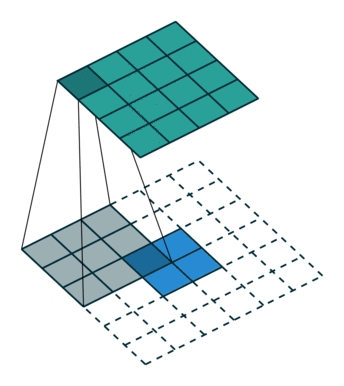Introduction
Szegedy et al. (2014)ではより深いDNNを実現するためにInception moduleを導入し,22層からなるGoogLenetを開発し,ほぼ同じ計算量で性能の向上を実現している.VGGNetは精度の点ではGoogLeNetと同程度だが,従来のCNNを深くしただけで,非常に計算量が大きいという欠点が有る.
ただ単にDNNを大きくすることは計算量を増大させると同時に必要なtraining dataを莫大にしてしまう. これを克服するためにsparsityを用いるのだが,sparse行列の演算は現在の計算機では扱いづらい. 従来は”spatial domain”においてconvolutionを導入してsparsityを実現してきたが,著者は”filter-level”でsparsityを実現し,しかも複数のsparse行列の演算を1つのdense行列の演算として近似して効率よく計算する方法を開発した.
Inception moduleとは通常のconvolutionの代わりに挿入される,複数のconvolutionをひとまとめにしたレイヤーと言える.
CNNでは局所的な統計量のクラスターが前のレイヤーから後ろのレイヤーに渡されていくわけだが,その受け渡されたレイヤーでももとの局所性は保存されているから,ついにはその局所的な統計量たちの殆どがfeature mapのうちの1x1の部分のそれぞれに格納されることになる. Inception moduleでは1x1のフィルタに加え,1x1の部分に収まりきらない局所統計量をとらえるため,3x3と5x5のフィルタも加え,ついでにpoolingも加えている(fig.1.a), .
大量のfeature mapが有る上に5X5のconvolutionを行うのは非常に計算が重いので,1x1のconvolutionを適当な枚数のfeature mapを作るように掛けて次元圧縮してからそれに3x3や5x5のconvolutionを施す(fig.1.b), (table1, n5x5redやn3x3redが次元圧縮した後の次元数).
計算上の理由から,Inception moduleはDNNのhigher layerにおいてのみ挿入される. GoogLeNetは合計で22のlayerからなるが,当時としてはあまりに深いネットワークなので,中頃の層にもclassifierを追加して(fig.2)勾配消失を軽減するとともに,regularizationを実現していると著者は考えている.

figure1
Table1, PyTorch実装,kuangliu, MIT license
import torch
import torch.nn as nn
import torch.nn.functional as F
from torch.autograd import Variable
class Inception(nn.Module):
def __init__(self, in_planes, n1x1, n3x3red, n3x3, n5x5red, n5x5, pool_planes):
super(Inception, self).__init__()
# 1x1 conv branch
self.b1 = nn.Sequential(
nn.Conv2d(in_planes, n1x1, kernel_size=1),
nn.BatchNorm2d(n1x1),
nn.ReLU(True),
)
# 1x1 conv -> 3x3 conv branch
self.b2 = nn.Sequential(
nn.Conv2d(in_planes, n3x3red, kernel_size=1),
nn.BatchNorm2d(n3x3red),
nn.ReLU(True),
nn.Conv2d(n3x3red, n3x3, kernel_size=3, padding=1),
nn.BatchNorm2d(n3x3),
nn.ReLU(True),
)
# 1x1 conv -> 5x5 conv branch
self.b3 = nn.Sequential(
nn.Conv2d(in_planes, n5x5red, kernel_size=1),
nn.BatchNorm2d(n5x5red),
nn.ReLU(True),
nn.Conv2d(n5x5red, n5x5, kernel_size=3, padding=1),
nn.BatchNorm2d(n5x5),
nn.ReLU(True),
nn.Conv2d(n5x5, n5x5, kernel_size=3, padding=1),
nn.BatchNorm2d(n5x5),
nn.ReLU(True),
)
# 3x3 pool -> 1x1 conv branch
self.b4 = nn.Sequential(
nn.MaxPool2d(3, stride=1, padding=1),
nn.Conv2d(in_planes, pool_planes, kernel_size=1),
nn.BatchNorm2d(pool_planes),
nn.ReLU(True),
)
def forward(self, x):
y1 = self.b1(x)
y2 = self.b2(x)
y3 = self.b3(x)
y4 = self.b4(x)
return torch.cat([y1,y2,y3,y4], 1)
class GoogLeNet(nn.Module):
def __init__(self):
super(GoogLeNet, self).__init__()
self.pre_layers = nn.Sequential(
nn.Conv2d(3, 192, kernel_size=3, padding=1),
nn.BatchNorm2d(192),
nn.ReLU(True),
)
self.a3 = Inception(192, 64, 96, 128, 16, 32, 32)
self.b3 = Inception(256, 128, 128, 192, 32, 96, 64)
self.maxpool = nn.MaxPool2d(3, stride=2, padding=1)
self.a4 = Inception(480, 192, 96, 208, 16, 48, 64)
self.b4 = Inception(512, 160, 112, 224, 24, 64, 64)
self.c4 = Inception(512, 128, 128, 256, 24, 64, 64)
self.d4 = Inception(512, 112, 144, 288, 32, 64, 64)
self.e4 = Inception(528, 256, 160, 320, 32, 128, 128)
self.a5 = Inception(832, 256, 160, 320, 32, 128, 128)
self.b5 = Inception(832, 384, 192, 384, 48, 128, 128)
self.avgpool = nn.AvgPool2d(8, stride=1)
self.linear = nn.Linear(1024, 10)
def forward(self, x):
out = self.pre_layers(x)
out = self.a3(out)
out = self.b3(out)
out = self.maxpool(out)
out = self.a4(out)
out = self.b4(out)
out = self.c4(out)
out = self.d4(out)
out = self.e4(out)
out = self.maxpool(out)
out = self.a5(out)
out = self.b5(out)
out = self.avgpool(out)
out = out.view(out.size(0), -1)
out = self.linear(out)
return out
# net = GoogLeNet()
# x = torch.randn(1,3,32,32)
# y = net(Variable(x))
# print(y.size())

figure 2
figureは原論文より





